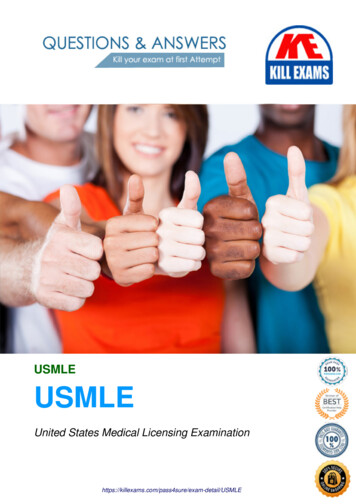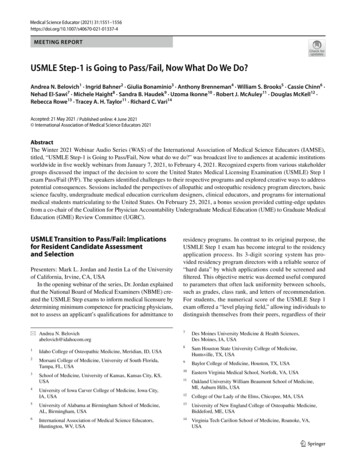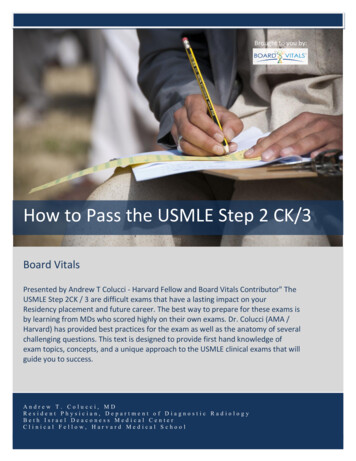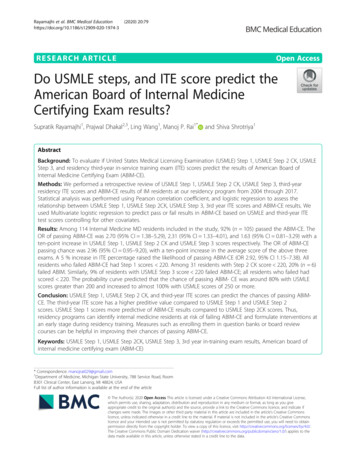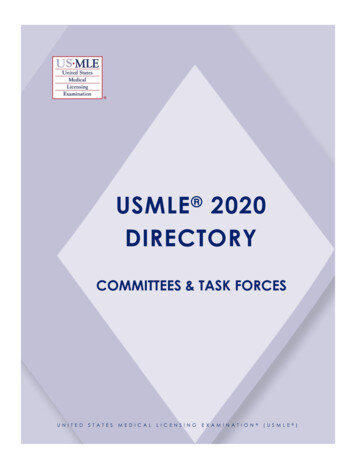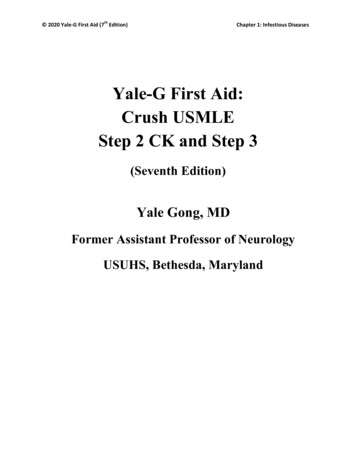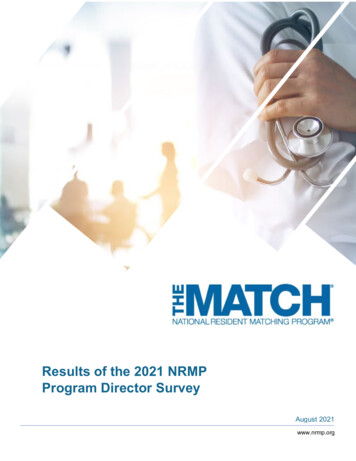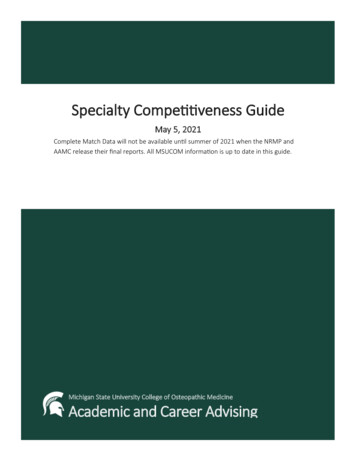
Transcription
Usmle step 2 secrets 5th edition pdf download 2017
In this blog post, we are going to share a USMLE books PDF, USMLE videos free download UWorld and everything you need to pass USMLE Steps. In order to ensure that user-safety is not compromised and you enjoy faster downloads, we have used trusted 3rd-party repository links that are not hosted on our website. At USMLEBooksDownload.com,we take user experience very seriously and thus always strive to improve. We hope that you people find our blog beneficial! USMLE Step 1 Books PDF USMLE Step 1 Lecture Notes 2019: 7-Book Set PDF Free Download First Aid for the USMLE Step 1 2019, 29th Edition PDF Free Download Kaplan Medical USMLE Step 1 Review Volume 1 PDF FreeDownload USMLE Platinum Notes Step 1: The Complete Preparatory Guide 2nd Edition PDF Free Download Best USMLE Step 1 Anatomy Books PDF Free Download [High Score Guaranteed] Becker’s USMLE Step 1 Lecture Notes PDF Free Download [Complete Series] First Aid Cases for the USMLE Step 1 3rd Edition PDF Free Download CrushUSMLE Step 1, Step 2 & Step 3 PDF Free Download [Complete Series] USMLE RX Step 1 Qbank 2019 Free Download Best USMLE Step 1 Books PDF Free Download [Highly Recommended] Anki Flashcards USMLE Step 1 Free Download USMLE Step 2 Books PDF USMLE Step 2 CK Lecture Notes 2019: Internal Medicine PDF Free Download FirstAid for the USMLE Step 2 CK 10th Edition PDF Free Download USMLE Step 2 Secrets 5th Edition PDF Free Download Step-Up to Medicine (Step-Up Series) 5th Edition PDF Free Download Brochert’s Crush Step 2: The Ultimate USMLE Step 2 Review 4th Edition PDF Free Download USMLE Step 2 CS Core Cases 3rd Edition PDF Free DownloadMaster the Boards USMLE Step 2 CK PDF Free Download USMLE Step 3 Books PDF First Aid for the USMLE Step 3 4th Edition PDF Free Download Internal Medicine Correlations and Clinical Scenarios (CCS) USMLE Step 3 PDF Free Download Master the Boards USMLE Step 3 6th Edition PDF Free Download USMLE Step 3 Lecture Notes 20192020: Internal Medicine, Psychiatry, Ethics PDF Free Download USMLE UWorld Step 1, Step 2 and Step 3 UWorld For USMLE Step 1 2019 PDF Free Download [Subject Wise] USMLE World QBank Step 1 UWORLD 2014 PDF Free Download UWorld For USMLE Step 1 2018 PDF Free Download [Subject Wise] Download UWorld 2017 For USMLEStep 2 CK PDF Free (System-Wise) UWorld Step 1 2019 General PDF Free Download NBME STEP 2 CK Form 1, 2, 3, 4 Offline With Answers Free Download USMLE Videos Free Download Doctors in Training USMLE Step 1 Videos Free Download Pathoma Videos Free Download – HD Quality Good luck and happy learning! 1996-2014,Amazon.com, Inc. or its affiliates Basic Information: Year: 2020 Page Number: 384 pages File Type: PDF File Size: 25.31491947 MB Authors/ Editiors: Latha Ganti MD Current, concise, and easy to use, the updated fifth edition of Step-Up to USMLE Step 2 CK makes essential information engaging and retainable, delivering the perfect exam prep fortoday’s busy medical student. Access just what you need to ace the USMLE Step 2 CK and make a confident transition to clinical practice with this high-yield, system-based review. This updated fifth edition of Step-Up to USMLE Step 2 CK helps you quickly memorize essential information and gives you the realistic test-taking practice to succeed.Full-color illustrations, “Quick Hits,” and mnemonics clarify must-know information on causes, risk factors, history and physical exam, lab studies and radiology, treatment, and complications for the most common diseases and disorders. USMLE-style study questions for each chapter mimic those found on the Step 2 exams, accompanied by completeexplanations for maximum comprehension and test preparation. This is definetely a book for revising, not for studying at first place. But I find it very useful for this. The number of pages is 364, not 653 as written in the description. A lot of tables, algorithms and pictures. Printed well, delivered very fast. I have been using this to study for USMLE Step2. The book is thorough and has been a lifesaver with my studying. Free Download Step-Up to USMLE Step 2 CK 5th Edition in PDF format Step-Up to USMLE Step 2 CK 5th Edition PDF Free Download Download Step-Up to USMLE Step 2 CK 5th Edition 2020 PDF Free Step-Up to USMLE Step 2 CK 5th Edition 2020 PDF Free Download DownloadStep-Up to USMLE Step 2 CK 5th Edition PDF Concise and easy to use, USMLE Step 2 Secrets, by prolific author Theodore X. O’Connell, MD, is an effective, high-yield review for achieving success on this high-stakes exam. Presented in the popular, time-tested Secrets Q&A format, this bestselling USMLE review book prepares you for the broadbased diagnosis, treatment, and management questions you’ll face on the vignette-style USMLE exam. The proven Secrets format gives you the most return for your time – concise, easy to read, engaging, and highly effective. Essential questions and answers cover the key conditions you will be expected to recognize, all specialty and subspecialtytopics, and necessary clinical concepts. Top 100 Secrets, tips, and memory aids provide a fast overview of the secrets you must know for success in practice and on exams. Portable size makes it easy to carry with you for quick reference or review anywhere, anytime. 100 Top Secrets Chapter 1. Acid-Base and Electrolytes Chapter 2. Alcohol Chapter 3.Biostatistics Chapter 4. Cardiology Chapter 5. Cholesterol Chapter 6. Dermatology Chapter 7. Diabetes Mellitus Chapter 8. Ear, Nose, and Throat Surgery Chapter 9. Emergency Medicine Chapter 10. Endocrinology Chapter 11. Ethics Chapter 12. Gastroenterology Chapter 13. General Surgery Chapter 14. Genetics Chapter 15. Geriatrics Chapter 16.Gynecology Chapter 17. Hematology Chapter 18. Hypertension Chapter 19. Immunology Chapter 20. Infectious Diseases Chapter 21. Laboratory Medicine Chapter 22. Nephrology Chapter 23. Neurology Chapter 24. Neurosurgery Chapter 25. Obstetrics Chapter 26. Oncology Chapter 27. Ophthalmology Chapter 28. Orthopedic Surgery Chapter 29.Pediatrics Chapter 30. Pharmacology Chapter 31. Preventive Medicine Chapter 32. Psychiatry Chapter 33. Pulmonology Chapter 34. Radiology Chapter 35. Rheumatology Chapter 36. Shock Chapter 37. Smoking Chapter 38. Urology Chapter 39. Vascular Surgery Chapter 40. Vitamins and MineralsNo. of pages: 424Language: EnglishCopyright: Elsevier 2017Published: May 6, 2017Imprint: ElsevierPaperback ISBN: 9780323496162eBook ISBN: 9780323528047Dr. Ted O'Connell is a family physician, educator, author, innovator, and speaker. He served as the founding director of Kaiser Permanente’s Napa-Solano family medicine residency program and serves as a clinical professor for UCSan Francisco, UC Davis, and Drexel University’s schools of medicine. He also founded Kaiser’s community medicine and global health fellowship. has authored or edited over a dozen textbooks, written numerous textbook chapters and peer-reviewed journal articles. Among his most notable are USMLE Step 2 Secrets, USMLE Step 3 Secrets, CrushStep 1, and the Instant Workups series of books. He is the Editor-In-Chief for Elsevier’s Clinical Key Meded education platform.Founding Director, Family Medicine, Kaiser Permanente Napa-Solano, Napa; Assistant Clinical Professor, Department of Community and Family Medicine, University of California, San Francisco, School of Medicine, SanFrancisco, CaliforniaWrite a reviewThere are currently no reviews for "USMLE Step 2 Secrets" Table of contents : 100 Top SecretsChapter 1. Acid-Base and ElectrolytesChapter 2. AlcoholChapter 3. BiostatisticsChapter 4. CardiologyChapter 5. CholesterolChapter 6. DermatologyChapter 7. Diabetes MellitusChapter 8. Ear, Nose, and ThroatSurgeryChapter 9. Emergency MedicineChapter 10. EndocrinologyChapter 11. EthicsChapter 12. GastroenterologyChapter 13. General SurgeryChapter 14. GeneticsChapter 15. GeriatricsChapter 16. GynecologyChapter 17. HematologyChapter 18. HypertensionChapter 19. ImmunologyChapter 20. Infectious DiseasesChapter 21. LaboratoryMedicineChapter 22. NephrologyChapter 23. NeurologyChapter 24. NeurosurgeryChapter 25. ObstetricsChapter 26. OncologyChapter 27. OphthalmologyChapter 28. Orthopedic SurgeryChapter 29. PediatricsChapter 30. PharmacologyChapter 31. Preventive MedicineChapter 32. PsychiatryChapter 33. PulmonologyChapter 34. RadiologyChapter 35.RheumatologyChapter 36. ShockChapter 37. SmokingChapter 38. UrologyChapter 39. Vascular SurgeryChapter 40. Vitamins and Minerals Citation preview Any screen. Any time. Anywhere. Activate the eBook version ge. of this title at no additional charge. Student Consult eBooks give you the power to browse and find content, view enhancedimages, share notes and highlights—both online and offline. Unlock your eBook today. 1 Visit studentconsult.inkling.com/redeem 2 Scratch off your code 3 Type code into “Enter Code” box 4 Click “Redeem” 5 Log in or Sign up 6 Go to “My Library” Scan this QR code to redeem your eBook through your mobile device: It’s that easy! Place Peel OffSticker Here For technical assistance: email [email protected] call 1-800-401-9962 (inside the US) call 1-314-447-8200 (outside the US) Use of the current edition of the electronic version of this book (eBook) is subject to the terms of the nontransferable, limited license granted on studentconsult.inkling.com. Access to the eBook is limited to the firstindividual who redeems the PIN, located on the inside cover of this book, at studentconsult.inkling.com and may not be transferred to another party by resale, lending, or other means. USMLE STEP 2 Fifth Edition This page intentionally left blankUSMLE STEP 2 Fifth Edition THEODORE X. O’CONNELL, MD Program Director FamilyMedicine Residency Program Kaiser Permanente Napa-Solano, California Assistant Clinical Professor Department of Community and Family Medicine University of California, San Francisco School of Medicine San Francisco, California 1600 John F. Kennedy Blvd. Ste 1800 Philadelphia, PA 19103-2899 USMLE STEP 2 SECRETS, 5th edition ISBN:978-0-323-49616-2 Copyright 2018 by Elsevier, Inc. All rights reserved. Previous editions copyrighted 2014, 2010, 2004 No part of this publication may be reproduced or transmitted in any form or by any means, electronic or mechanical, including photocopying, recording, or any information storage and retrieval system, without permission inwriting from the publisher. Details on how to seek permission, further information about the Publisher’s permissions policies and our arrangements with organizations such as the Copyright Clearance Center and the Copyright Licensing Agency, can be found at our website: www.elsevier.com/permissions. This book and the individual contributionscontained in it are protected under copyright by the Publisher (other than as may be noted herein). Notices Knowledge and best practice in this field are constantly changing. As new research and experience broaden our understanding, changes in research methods, professional practices, or medical treatment may become necessary. Practitionersand researchers must always rely on their own experience and knowledge in evaluating and using any information, methods, compounds, or experiments described herein. In using such information or methods they should be mindful of their own safety and the safety of others, including parties for whom they have a professional responsibility. Withrespect to any drug or pharmaceutical products identified, readers are advised to check the most current information provided (i) on procedures featured or (ii) by the manufacturer of each product to be administered, to verify the recommended dose or formula, the method and duration of administration, and contraindications. It is the responsibilityof practitioners, relying on their own experience and knowledge of their patients, to make diagnoses, to determine dosages and the best treatment for each individual patient, and to take all appropriate safety precautions. To the fullest extent of the law, neither the Publisher nor the authors, contributors, or editors, assume any liability for any injuryand/or damage to persons or property as a matter of products liability, negligence or otherwise, or from any use or operation of any methods, products, instructions, or ideas contained in the material herein. Library of Congress Cataloging-in-Publication Data Names: O’Connell, Theodore X., author. Title: USMLE step 2 secrets / Theodore X.O’Connell. Other titles: USMLE step two secrets United States Medical LicensingExamination step 2 secrets Secrets series. Description: Fifth edition. Philadelphia, PA : Elsevier, [2018] Series:Secrets series Includes bibliographical references and index. Identifiers: LCCN 2017007823 ISBN 9780323496162 (pbk. : alk. paper) Subjects: MESH: Clinical Medicine Examination Questions Classification: LCC RC58 NLM WB 18.2 DDC 616.0076--dc23 LC record available at Content Strategist: Jim Merritt Content Development Specialist: Angie Breckon Publishing Services Manager: Patricia Tannian Project Manager: Ted Rodgers Design Direction: Bridget Hoette Printed in China Lastdigit is the print number: 9 8 7 6 5 4 3 2 1 To Nichole, Ryan, Sean, and Claire. I love you. CONTENTS 100 TOP SECRETS 1CHAPTER 1 ACID-BASE AND ELECTROLYTES CHAPTER 2 ALCOHOL 21 CHAPTER 3 BIOSTATISTICS 24 CHAPTER 4 CARDIOLOGY 30 CHAPTER 5 CHOLESTEROL 45 CHAPTER 6 DERMATOLOGY 48CHAPTER 7 DIABETES MELLITUS 59 CHAPTER 8 EAR, NOSE, AND THROAT SURGERY 63 CHAPTER 9 EMERGENCY MEDICINE 67 CHAPTER 10 ENDOCRINOLOGY 70 CHAPTER 11 ETHICS 77 CHAPTER 12 GASTROENTEROLOGY 80 CHAPTER 13 GENERAL SURGERY CHAPTER 14 GENETICS 111 CHAPTER 15 GERIATRICS116 CHAPTER 16 GYNECOLOGY 119 CHAPTER 17 HEMATOLOGY 129 CHAPTER 18 HYPERTENSION 143 CHAPTER 19 IMMUNOLOGY 147 CHAPTER 20 INFECTIOUS DISEASES 153 CHAPTER 21 LABORATORY MEDICINE 170 CHAPTER 22 NEPHROLOGY 172 CHAPTER 23 NEUROLOGY 178 CHAPTER 24 NEUROSURGERY 190CHAPTER 25 OBSTETRICS 195 CHAPTER 26 ONCOLOGY 215 CHAPTER 27 OPHTHALMOLOGY 235 CHAPTER 28 ORTHOPEDIC SURGERY 242 vi 100 15 CONTENTS vii CHAPTER 29 PEDIATRICS 249 CHAPTER 30 PHARMACOLOGY 256 CHAPTER 31 PREVENTIVE MEDICINE 261 CHAPTER 32 PSYCHIATRY 264 CHAPTER 33 PULMONOLOGY 275 CHAPTER 34 RADIOLOGY 281 CHAPTER 35 RHEUMATOLOGY 284 CHAPTER 36 SHOCK 291 CHAPTER 37 SMOKING 294 CHAPTER 38 UROLOGY 295 CHAPTER 39 VASCULAR SURGERY 300 CHAPTER 40 VITAMINS AND MINERALS 304 INDEX 307A list of errata for this book can be found atwww.tedxoconnell.com. I also welcome you to visit the website to submit errors, updates, or suggestions for this book. Thank you for helping to ensure the accuracy and high quality of USMLE Step 2 Secrets. — THEODORE X. O’CONNELL 100 TOP SECRETS These secrets are 100 of the top board alerts. They summarize the concepts, principles, andmost salient details that you should review before you take the Step 2 examination. Understanding of these Top Secrets will serve you well in your final review. 1. Smoking is the number-one cause of preventable morbidity and mortality in the United States (e.g., atherosclerosis, cancer, chronic obstructive pulmonary disease). 2. Alcohol is thenumber-two cause of preventable morbidity and mortality in the United States. More than half of accidental and intentional (e.g., murder and suicide) deaths involve alcohol. Alcohol is the number-one cause of preventable mental retardation (fetal alcohol syndrome); it also causes cancer and cirrhosis and is potentially fatal in withdrawal. 3. Inalcoholic hepatitis, the classic ratio of aspartate aminotransferase to alanine aminotransferase is greater than or equal to 2:1, although both may be elevated. 4. Vitamins: give folate to reproductive-age women prior to conception and throughout pregnancy to prevent neural tube defects. Watch for pernicious anemia, and treat with vitamin B12 toprevent permanent neurologic deficits. Isoniazid causes pyridoxine (vitamin B6) deficiency. Watch for Wernicke encephalopathy in alcoholics and treat with thiamine to prevent Korsakoff dementia. Consider offering vitamin D supplementation to geriatric adults who are at increased risk of falls or have a history of recurrent falls. 5. Minerals: irondeficiency anemia is the most common cause of anemia. Think of menstrual loss in reproductive-age women and of cancer in men and menopausal women if no other cause is obvious. 6. Vitamin A is a known teratogen. Counsel and treat reproductive-age women appropriately (e.g., take care in treating acne with the vitamin A analog isotretinoin). 7. Complications of atherosclerosis (e.g., myocardial infarction, heart failure, stroke, gangrene) are involved in roughly one-half of deaths in the United States. The primary risk factors for atherosclerosis are age/sex, family history, cigarette smoking, hypertension, diabetes mellitus, high low-density lipoprotein (LDL) cholesterol, and low high-densitylipoprotein (HDL) cholesterol. 8. Diabetes leads to macrovascular and microvascular disease. Macrovascular disease includes coronary artery disease, stroke, and peripheral vascular disease (a leading cause of limb amputation). Microvascular disease includes retinopathy (a leading cause of blindness), nephropathy (a leading cause of end-stage renalfailure), and peripheral neuropathy (sensory and autonomic). Diabetes also leads to an increased incidence of infections. 9. Although hypertension is often clinically silent, it can lead to end-organ damage such as renal failure, stroke, myocardial infarction, and heart failure. Severe hypertension can lead to acute problems (known as a hypertensiveemergency): headaches, dizziness, blurry vision, papilledema, cerebral edema, altered mental status, seizures, intracerebral hemorrhage (classically in the basal ganglia), renal failure/azotemia, angina, pulmonary edema, aortic dissection, myocardial infarction, and/or heart failure. 10. Lifestyle modifications (e.g., diet, exercise, weight loss, cessationof alcohol/tobacco use) may be able to treat the following disorders without the use of medications: hypertension, hyperlipidemia, diabetes, gastroesophageal reflux disease, insomnia, obesity, and sleep apnea. 1 2 100 TOP SECRETS 11. Arterial blood gas analysis: in general, pH tells you the primary event (acidosis vs. alkalosis), whereas carbondioxide and bicarbonate values give you the cause (same direction as pH) and suggest any compensation present (opposite of pH). 12. Exogenous causes of hyponatremia to keep in mind: oxytocin, surgery, narcotics, inappropriate intravenous (IV) fluid administration, diuretics, and antiepileptic medications. 13. EKG findings in electrolytedisturbances: tall, tented T waves in hyperkalemia; loss of T waves/T-wave flattening and U waves in hypokalemia; QT prolongation in hypocalcemia; QT shortening in hypercalcemia. 14. Shock: first give the patient oxygen, start an IV line, and set up monitoring (pulse oximetry, EKG, frequent vital signs). Then give a fluid bolus (30 cc/kg of normalsaline or lactated Ringer solution) if no signs of congestive heart failure (e.g., bibasilar rales) are present while you try to figure out the cause if it is not known. If the patient is not responsive to fluids, start cardiac pressors. 15. Virchow triad of deep venous thrombosis: endothelial damage (e.g., surgery, trauma), venous stasis (e.g., immobilization,surgery, severe heart failure), and hypercoagulable state (e.g., malignancy, birth control pills, pregnancy, lupus anticoagulant, inherited deficiencies). 16. Therapy for congestive heart failure: diuretics (e.g., furosemide), angiotensinconverting enzyme inhibitors, and beta-blockers (for stable patients) are the mainstays of pharmacologic treatment. Besure to screen for and address underlying atherosclerosis risk factors (e.g., smoking, hyperlipidemia). Most patients should be on antiplatelet therapy (e.g., aspirin). 17. Cor pulmonale: right-sided heart enlargement, hypertrophy, or failure due to primary lung disease (usually chronic obstructive pulmonary disease). The most common cause of rightheart failure, however, is left-heart failure (not cor pulmonale). 18. In patients with atrial fibrillation, assess for an underlying cause with thyroid-stimulating hormone, electrolytes, urine drug screen, and echocardiogram. The main management issues are ventricular rate control (if needed, slow the rate with medications) and atrial clotformation/embolic disease (consider anticoagulation with warfarin or a novel oral anigoagulant). 19. Ventricular fibrillation and pulseless ventricular tachycardia are treated with immediate defibrillation followed by epinephrine, vasopressin, amiodarone, and lidocaine. If ventricular tachycardia with a pulse is present, treat with amiodarone andsynchronized cardioversion. 20. Obstructive vs. restrictive lung disease: the FEV1/FVC ratio is the most important parameter on pulmonary function testing to distinguish the two (FEV1 may be the same). In obstructive lung disease, the FEV1/FVC ratio is less than normal (50 yr for all studies Every 10 yr Every 5 yr Every 5 yr Every 5 yr AnnuallyAnnually Every 3 yr Continued on following page 6 100 TOP SECRETS CANCER AGE FREQUENCY Colon, prostate Digital rectal exam PROCEDURE 40 yr Prostate Prostate specific antigen test 50 yr* Cervical Pap smear Beginning at age 21 yr regardless of sexual activity Annually, though benefits are uncertain and guidelines vary Have arisk/benefit discussion with appropriate patients. Routine screening no longer recommended. If conventional Pap test is used, test every 3 yr from ages 21 to 65. Pap and HPV co-testing should not be used for women 50 yr Lung Low-dose CT scan This table is for the screening of asymptomatic, healthy patients. Other guidelines exist, but you’ll be fineif you follow this table for the USMLE. Controversial areas usually are not tested on the USMLE. *Start at age 45 in African Americans and at age 40 for patients with a first-degree relative diagnosed at an early age. 47. Biostatistics calculations using a 2 2 table DISEASE Test or Exposure ( ) (–) ( ) (–) A C B D TEST NAME FORMULA SensitivitySpecificity PPV NPV Odds ratio Relative risk Attributable risk A/(A C) D/(B D) A/(A B) D/(C D) (A D)/(B C) [A/(A B)] / [C/(C D)] [A/(A B)] – [C/(C D)] 48. The P-value reflects the likelihood of making a type I error, or claiming an effect or difference where none existed (i.e., results were obtained by chance). When we reject the nullhypothesis (i.e., the hypothesis of no difference) in a trial testing a new treatment, we are saying that the new treatment works. We use the P-value to express our confidence in the data. 49. Side effects of antipsychotics: acute dystonia (treat with antihistamines or anticholinergics), akathisia (beta-blocker may help), tardive dyskinesia (switching tonewer agent may have benefit), parkinsonism (treat with antihistamines or anticholinergics), neuroleptic malignant syndrome, hyperprolactinemia (may cause breast discharge, menstrual dysfunction, and/or sexual dysfunction), and autonomic nervous system–related effects (e.g., anticholinergic, antihistamine, and alpha1-receptor blockade). 100 TOPSECRETS7 50. Asking about depression and suicidal thoughts/intent is important in the right setting and does not cause people to commit suicide. Hospitalize psychiatric patients against their will if they are a danger to self or others or gravely disabled (unable to care for self). 51. Drugs of abuse: potentially fatal in withdrawal include alcohol,barbiturates, and benzodiazepines. Alcohol, cocaine, opiates, barbiturates, benzodiazepines, phencyclidine (PCP), and inhalants are potentially fatal in overdose. 52. Pelvic inflammatory disease is the most common preventable cause of infertility in the United States and the most likely cause of infertility in younger, normally menstruating women. 53. Polycystic ovarian syndrome is classically associated with women who are “heavy, hirsute, and [h]amenorrheic.” It is the most common cause of dysfunctional uterine bleeding. Remember the increased risk of endometrial cancer due to unopposed estrogen. 54. Fetal/neonatal macrosomia is due to maternal diabetes until proven otherwise. Treatgestational/maternal diabetes by aiming for tight glucose control through diet, oral agents, or insulin. 55. Low maternal serum alpha-fetoprotein causes: Down syndrome, inaccurate dates (most common), and fetal demise. High maternal serum alpha-fetoprotein associated with: neural tube defects, ventral wall defects (e.g., omphalocele,gastroschisis), inaccurate dates (most common), and multiple gestation. Measurement is generally obtained between 16 and 20 weeks’ gestation. 56. Hypertension plus proteinuria in pregnancy equals preeclampsia until proven otherwise. 57. Positive pregnancy test (i.e., not a clinically apparent pregnancy) plus vaginal bleeding and abdominal painequals ectopic pregnancy until proven otherwise. Order a pelvic ultrasound if the patient is stable. 58. Decelerations during maternofetal monitoring: early decelerations are normal and due to head compression. Variable decelerations are common and usually due to cord compression (turn the mother on her side, give oxygen and fluids, stop oxytocin,and consider amnioinfusion). Late decelerations are due to uteroplacental insufficiency and are the most worrisome pattern (turn the mother on her side, give oxygen and IV fluids, stop oxytocin, and measure fetal oxygen saturation or scalp pH). Prepare for prompt delivery. 59. Always perform an ultrasound before a pelvic exam in the setting of thirdtrimester bleeding (in case placenta previa is present). 60. Uterine atony is the most common cause of postpartum bleeding and is typically due to uterine overdistention (e.g., twins, polyhydramnios), prolonged labor, fibroids, and/or oxytocin usage. The risk is increased in multiparous women. 61. Acute abdomen pathology localization by physicalexam AREA ORGAN (CONDITIONS) Right upper quadrant Left upper quadrant Right lower quadrant Left lower quadrant Epigastric area Gallbladder/biliary (cholecystitis, cholangitis) or liver (abscess) Spleen (rupture with blunt trauma) Appendix (appendicitis), pelvic inflammatory disease Sigmoid colon (diverticulitis), pelvic inflammatory diseaseStomach (peptic ulcer) or pancreas (pancreatitis) 62. The “6 Ws” of postoperative fever: water, wind, walk, wound, “wawa,” and weird drugs. Water stands for urinary tract infection, wind for atelectasis or pneumonia, walk for deep venous thrombosis, wound for surgical wound infection, “wawa” for breast (usually relevant only in the postpartumstate), and weird drugs for drug fever. In patients with daily fever spikes that do not respond to antibiotics, think about a postsurgical abscess. Order a CT scan to locate, then drain the abscess if one is present. 8 100 TOP SECRETS 63. ABCDEs of trauma (follow in order if you are asked to choose): airway, breathing, circulation, disability, andexposure. 64. Six rapidly fatal thoracic injuries that must be recognized and treated immediately: 1. Airway obstruction (establish airway) 2. Open pneumothorax (intubate, place chest tube at different site, and close defect on three sides) 3. Tension pneumothorax (perform needle thoracentesis followed by chest tube) 4. Cardiac tamponade (performpericardiocentesis) 5. Massive hemothorax (place chest tube to drain; thoracotomy if bleeding does not stop) 6. Flail chest (consider intubation and positive pressure ventilation if oxygenation inadequate) 65. Neonatal conjunctivitis may be caused by chemical reaction (in the first 12–24 hours of giving drops for prophylaxis), gonorrhea (2–5 days afterbirth; usually prevented by prophylactic drops), and chlamydial infection (5–14 days after birth; often not prevented by prophylactic drops). 66. Glaucoma is usually (90%) due to the open-angle form, which is painless (no “attacks”) and asymptomatic until irreversible vision loss (that starts in the periphery) occurs. Thus, screening is important. Openangle glaucoma is the most common cause of blindness in African Americans. 67. Uveitis is often a marker for systemic conditions: juvenile rheumatoid arthritis, sarcoidosis, inflammatory bowel disease, ankylosing spondylitis, reactive arthritis, multiple sclerosis, psoriasis, or lupus. Photophobia, blurry vision, and eye pain are common complaints. 68. Bilateral (though often asymmetric) painless gradual loss of vision in older adults is usually due to cataracts, macular degeneration, or glaucoma, which can be distinguished on physical exam. Presbyopia is a normal part of aging and affects only near vision (i.e., accommodation). 69. Compartment syndrome, usually in the lower extremity after traumaor surgery, causes the “6 Ps”: 1. Pain (present on passive movement and often out of proportion to the injury) 2. Paresthesias (numbness, tingling, decreased sensation) 3. Pallor (or cyanosis) 4. Pressure (firm feeling muscle compartment, elevated pressure reading) 5. Paralysis (late, ominous sign) 6. Pulselessness (very late, ominous sign) Treat withfasciotomy to relieve compartment pressure and prevent permanent neurologic damage. 70. Peripheral nerve evaluation NERVE Radial MOTOR FUNCTION Wrist extension (watch for wrist drop) Ulnar Finger abduction (watch for “claw hand”) Median Forearm pronation, thumb opposition Axillary Shoulder abduction, lateral rotation Peroneal Footdorsiflexion, eversion (watch for foot drop) SENSORY FUNCTION CLINICAL SCENARIO Back of forearm, back of hand (first 3 digits) Front and back of last 2 digits Palmar surface of hand (first 3 digits) Lateral shoulder Humeral fracture Dorsal foot and lateral leg Elbow dislocation Carpal tunnel syndrome, humeral fracture Upper humeraldislocation or fracture Knee dislocation 100 TOP SECRETS9 71. Pediatric hip disorders NAME AGE CHD At birth LCPD SCFE EPIDEMIOLOGY Female, first-borns, breech delivery 4–10 yr S
USMLE Step 1 Books PDF USMLE Step 1 Lecture Notes 2019: 7-Book Set PDF Free Download First Aid for the USMLE Step 1 2019, 29th Edition PDF Free Download Kaplan Medical USMLE Step 1 Review Volume 1 PDF Free Download USMLE Platinum Notes Step 1: The Complete Preparatory Guide 2nd Edition PDF Free Download Best USMLE Step 1 Anatomy Books PDF Free .

